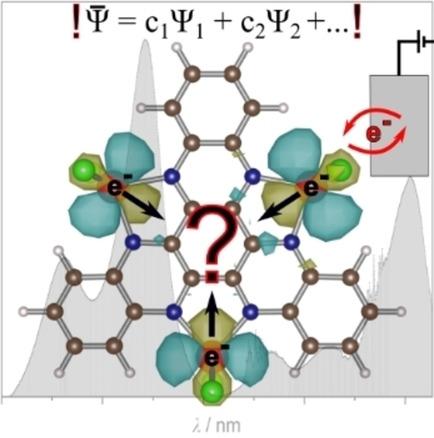当前位置:
X-MOL 学术
›
ChemPhysChem
›
论文详情
Our official English website, www.x-mol.net, welcomes your
feedback! (Note: you will need to create a separate account there.)
Electronic transitions in different redox states of trinuclear 5,6,11,12,17,18-hexaazatrinaphthylene-bridged titanium complexes: Spectroelectrochemistry and quantum chemistry.
ChemPhysChem ( IF 2.3 ) Pub Date : 2020-09-23 , DOI: 10.1002/cphc.202000547 Aleksandra Markovic 1 , Luca Gerhards 1 , Pia Sander 1 , Carsten Dosche 1 , Thorsten Klüner 1 , Rüdiger Beckhaus 1 , Gunther Wittstock 1
ChemPhysChem ( IF 2.3 ) Pub Date : 2020-09-23 , DOI: 10.1002/cphc.202000547 Aleksandra Markovic 1 , Luca Gerhards 1 , Pia Sander 1 , Carsten Dosche 1 , Thorsten Klüner 1 , Rüdiger Beckhaus 1 , Gunther Wittstock 1
Affiliation

|
Multinuclear transition metal complexes bridged by ligands with extended π‐electronic systems show a variety of complex electronic transitions and electron transfer reactions. While a systematic understanding of the photochemistry and electrochemistry has been attained for binuclear complexes, much less is known about trinuclear complexes such as hexaphenyl‐5,6,11,12,17,18‐hexaazatrinaphthylene‐tristitanocene [(Cp2Ti)3HATN(Ph)6]. The voltammogram of [(Cp2Ti)3HATN(Ph)6] shows six oxidation and three reduction waves. Solution spectra of [(Cp2Ti)3HATN(Ph)6] and of the electrochemically formed oxidation products show electronic transitions in the UV, visible and the NIR ranges. Density functional theory (DFT) and linear response time‐dependent DFT show that the three formally titanium(II) centers transfer an electron to the HATN ligand in the ground state. The optically excited transitions occur exclusively between ligand‐centered orbitals. The charged titanium centers only provide an electrostatic frame to the extended π‐electronic system. Complete active self‐consistent field (CASSCF) calculation on a structurally simplified model compound, which considers the multi‐reference character imposed by the three titanium centers, can provide an interpretation of the experimentally observed temperature‐dependent magnetic behavior of the different redox states of the title compound in full consistency with the interpretation of the electronic spectra.
中文翻译:

三核 5,6,11,12,17,18-六氮杂萘桥钛配合物不同氧化还原态的电子跃迁:光谱电化学和量子化学。
由具有扩展π电子系统的配体桥接的多核过渡金属配合物表现出各种复杂的电子跃迁和电子转移反应。虽然人们对双核配合物的光化学和电化学有了系统的了解,但对三核配合物如六苯基-5,6,11,12,17,18-六氮杂萘-三钛茂[(Cp 2 Ti) 3 HATN]知之甚少。 (博士) 6 ]。 [(Cp 2 Ti) 3 HATN(Ph) 6 ]的伏安图显示出六个氧化波和三个还原波。 [(Cp 2 Ti) 3 HATN(Ph) 6 ]和电化学形成的氧化产物的溶液光谱显示了紫外、可见光和近红外范围内的电子跃迁。密度泛函理论 (DFT) 和线性响应时间相关的 DFT 表明,三个形式的钛 (II) 中心将电子转移到基态的 HATN 配体。光激发跃迁仅发生在配体中心轨道之间。带电的钛中心仅为扩展的π电子系统提供静电框架。对结构简化的模型化合物进行完整的活性自洽场(CASSCF)计算,考虑了三个钛中心所施加的多参考特征,可以解释实验观察到的不同氧化还原态的温度依赖性磁性行为。标题化合物与电子光谱的解释完全一致。
更新日期:2020-11-18
中文翻译:

三核 5,6,11,12,17,18-六氮杂萘桥钛配合物不同氧化还原态的电子跃迁:光谱电化学和量子化学。
由具有扩展π电子系统的配体桥接的多核过渡金属配合物表现出各种复杂的电子跃迁和电子转移反应。虽然人们对双核配合物的光化学和电化学有了系统的了解,但对三核配合物如六苯基-5,6,11,12,17,18-六氮杂萘-三钛茂[(Cp 2 Ti) 3 HATN]知之甚少。 (博士) 6 ]。 [(Cp 2 Ti) 3 HATN(Ph) 6 ]的伏安图显示出六个氧化波和三个还原波。 [(Cp 2 Ti) 3 HATN(Ph) 6 ]和电化学形成的氧化产物的溶液光谱显示了紫外、可见光和近红外范围内的电子跃迁。密度泛函理论 (DFT) 和线性响应时间相关的 DFT 表明,三个形式的钛 (II) 中心将电子转移到基态的 HATN 配体。光激发跃迁仅发生在配体中心轨道之间。带电的钛中心仅为扩展的π电子系统提供静电框架。对结构简化的模型化合物进行完整的活性自洽场(CASSCF)计算,考虑了三个钛中心所施加的多参考特征,可以解释实验观察到的不同氧化还原态的温度依赖性磁性行为。标题化合物与电子光谱的解释完全一致。











































 京公网安备 11010802027423号
京公网安备 11010802027423号